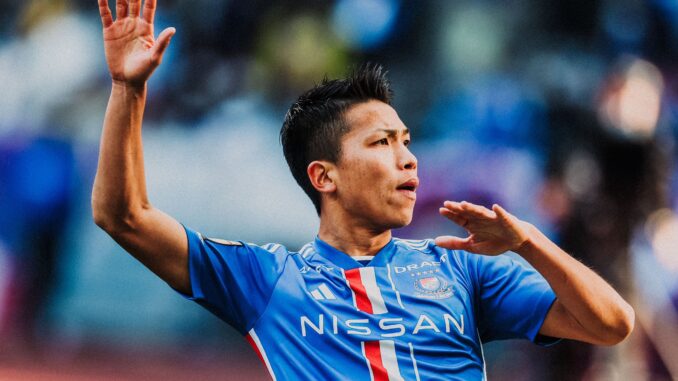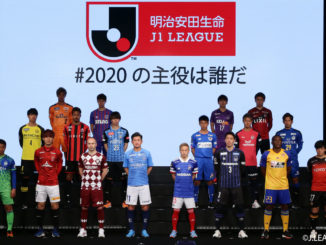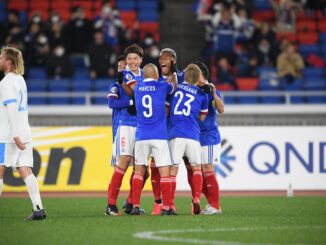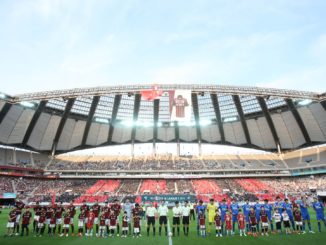
After one of the longer off-season breaks in recent years, the J.League returns for a 31st season in a now firmly established position as Asia’s best league, both in terms of the quality on the pitch and the way that things are run off it.
Title holders, Yokohama F. Marinos, will be the side that everyone is aiming to knock off, promoted pair Albirex Niigata and Yokohama FC will be looking to surprise and right across the league there’s a flood of young talents waiting to be released.
In our annual pre-season guide to J1, we break down the contenders, the challengers and the strugglers as well as highlighting some of the younger talents sure to be on the radar of bigger clubs by the time that things are done in 2023.
CONTENDERS (Yokohama F. Marinos, Sanfrecce Hiroshima, Nagoya Grampus, Kawasaki Frontale, Urawa Red Diamonds, FC Tokyo)
For the first time in several years there doesn’t appear to be a clear standout as the team to beat but, even with a couple of key losses, Yokohama F. Marinos seem likely once again to be a serious challenger.
Last season, Tomoki Iwata was one of the more underwhelming MVP choices in recent times and that spoke as much to the team’s cohesive structure as it did to the individuals within it.
A huge amount of credit has to go to Kevin Muscat and his staff, not just for the results or the tactical elements that led to them, but to the actual coaching and development of players that were fringe options elsewhere but blossomed at the Nissan Stadium.
Takuma Nishimura, Ryuta Koike, Joel Fujita and Kota Watanabe are just some of those whose careers have been taken to the next level by Muscat and the club are sitting on an absolute gem in young defender Ryotaro Tsunoda who, with another year in the system, could easily be a part of the Japan setup for the next Asian Cup.
With the front three also returning there will be goals for sure and, along with Hiroshima and Nagoya, they’re my tip as the most likely title contenders.
The biggest challenge may well come from a Sanfrecce Hiroshima side that also showed the clear advantage Japanese teams have when they appoint good foreign coaches.
Michael Skibbe, in the space of a year, took a side that was somewhere between grafting and functional to the point of being one of the most entertaining in the nation.
Essentially he did it with the same group of players from the year prior although the sprinkling in of some young (Makoto Mitsuta) and previously overlooked (Gakuto Notsuda) players certainly helped, and if he can coax goals out of the man most likely to lead the line in Nassim Ben Khalifa then there’s no reason they couldn’t win the title.
If they had a coach that was more willing to let go of the handbrake then Nagoya Grampus could well be my title favourites but it’s hard to know just how adventurous Kenta Hasegawa will let the side be.
The return of veteran Takuji Yonemoto and the addition of experienced defender Yuki Nogami in front of the league’s best goalkeeper, Mitch Langerak, means that Grampus will again be hard to break down.
It’s up front though where they’ve made the best pickup of the entire transfer window with the loan arrival of Kasper Junker.
Just what Urawa were thinking in letting the 28-year-old Danish striker go is anyone’s guess but if he stays fit he has the potential to be close to a goal-a-game striker and could easily be a driving force in a Grampus title win in 2023.
If Nagoya were involved in the best piece of business then Kawasaki Frontale claim the gong for the worst in letting their captain, Shogo Taniguchi, move to Qatar for a song and then replace him with something that barely whistles a tune.
The plan apparently appears to be praying that the league’s best central defender, Jesiel, stays fit because the other elements in the scheme involve converting a leftback to a central defender and not really offering any meaningful depth at any of the three defensive positions.
Factor in that last year they signed Thai ace Chanathip Songkrasin – as out-and-out of a number ten as you’ll find in a system that doesn’t employ a ten – and couldn’t figure out how to use him, as well as the fact that their two best creative/scoring threats in the superb Akihiro Ienaga and Leandro Damiao will miss the first part of the season through injury and Frontale could well, by their standards, struggle this year.
As with the other contenders though they have a fine tactician at the helm and for that fact alone they can’t be written off but it might be the emergence of a young talent that could spark the side, and in the electric Toya Myogan many in the know believe they could be sitting on the next Kaoru Mitoma, an outstanding young winger who could take the league by storm in 2023.
Urawa Red Diamonds opted to replace one foreign coach with another as the decorated Polish mentor Maciej Skorza takes charge of a club whose shadow always seems larger than their actual body of work.
There’s no denying the quality right across the squad with an experienced defensive core, one of Japan’s best young midfielders in Atsuki Ito controlling things in the middle of the pitch and the lively David Moberg Karlsson and Yoshio Koizumi providing creativity from both wide and central areas.
The clear issue is that, with the departure of Junker, there’s the need for a central striker to emerge and if Bryan Linssen can be that player – as hopes are that he will be – then Reds will be right in the thick of the title race.
The best of the outside title contenders may be FC Tokyo in the second season under the progressive Spanish coach, Albert Puig, and their newish owners, Mixi, who have done a solid job in trying to rebrand the capital club – no mean feat for a company that’s, in some quarters, still associated with the kind of faded social network that would be the equivalent of having Myspace take over your football club.
In central midfielder Kuryu Matsuki, left fullback Kashifu Bangnagande and left winger Kota Tawaratsumida they have a couple of budding young talents, a fine shot stopping keeper in Jakub Slowik and more Brazilian attackers than can fit in the front three positions that Puig deploys.
Pure creativity and finishing may be the areas that let them down but Tokyo should be a steady top six presence for much of the campaign.
YOKOHAMA F.MARINOS
COACH: Kevin MUSCAT
KEY PLAYERS: Takuya Kida, Elber
PLAYERS TO WATCH: Ryotaro Tsunoda, Joel Fujita
SANFRECCE HIROSHIMA
COACH: Michael SKIBBE
KEY PLAYERS: Makoto Mitsuta, Gakuto Notsuda
PLAYERS TO WATCH: Shuto Nakano, Sota Koshimichi
NAGOYA GRAMPUS
COACH: Kenta HASEGAWA
KEY PLAYERS: Mitch Langerak, Kasper Junker
PLAYERS TO WATCH: Ryotaro Ishida, Hidemasa Koda
KAWASAKI FRONTALE
COACH: Toru ONIKI
KEY PLAYERS: Akihiro Ienaga, Jesiel
PLAYERS TO WATCH: Toya Myogan, Shin Yamada
URAWA RED DIAMONDS
COACH: Maciej SKORZA
KEY PLAYERS: Alexander Scholz, Ken Iwao
PLAYERS TO WATCH: Kaito Yasui, Zion Suzuki
FC TOKYO
COACH: Albert PUIG
KEY PLAYERS: Masato Morishige, Teruhito Nakagawa
PLAYERS TO WATCH: Kota Tawaratsumida, Naoki Kumata
CHALLENGERS (Vissel Kobe, Cerezo Osaka, Gamba Osaka, Sagan Tosu, Kashima Antlers, Kashiwa)
Vissel Kobe have, oddly and perhaps only for now, veered away from the Galacticos approach of the past half-decade and that may be the answer they were searching for in trying an approach to progress that is more measured than breakneck speed.
The recent signing of Brazilian keeper, Phelipe Megiolaro, looks to have fixed a real problem area and with a front three of Koya Yuruki, Yuya Osako and Yoshinori Muto, they have the talent to feed off the fading creativity of Andres Iniesta in a year where a cup may be within their reach but perhaps the league may not.
Shinji Kagawa’s return to his former home at Cerezo Osaka has stolen the headlines but the club has a nice blend of youth (forwards Sota Kitano and Shota Fujio, in particular) and experience (Kim Jin-hyeon, Matej Jonjic, Riki Harakawa and Hiroshi Kioytake is one of the best ‘spines’ in the division) that could well see them push into the top six come the season’s end.
Their neighbours, Gamba Osaka, made a slightly unexpected appointment in ex-Tokushima boss Daniel Poyatos to hopefully lead them into a new era after sniffing around and failing to land other promising young J2 coaches.
There’s no question that this squad is far better than the one at Vortis that he led into some kind of draw producing specialists last year, although question marks at either end of the pitch may perhaps determine how their season will play out.
Will it be the veteran Masaaki Higashiguchi or the promising, but still far from flawless, Kosei Tani who wins the keeping job? Will Tunisian forward Issam Jebali score the goals that other strikers have failed to at the club? Will the adventurous signing of Israeli holding midfielder Neta Lavi work and will the collection of promising young talents (Jiro Nakamura, Hiroto Yamami and Rihito Yamamoto etc) be given the chance to flourish?
Sagan Tosu have done a fantastic job to reinvent themselves year after year with a small budget and a constant stream of their best young talents being poached by bigger clubs both home and abroad.
What is often overlooked/perhaps not understood about the club is that they have an exceptional youth system, arguably the best in the land: their U18 side won the nationwide Prince Takamado Cup last year and their U15s have won the defacto national championship for three of the past six seasons (being losing finalists on another occasion).
That’s a simply astonishing success rate and the steady stream of players from the youth ranks into the senior setup is also impressive with the likes of Fuchi Honda and Shinya Nakano both having graduated from the production line; add in Japan’s best young coach in Kenta Kawai and the ingredients are there for Tosu to surprise many in 2023.
One club that may surprise in a negative way is Kashima Antlers, a heavyweight of the domestic scene and Japan’s most successful side of the J.League era.
Their recruitment has been somewhat confusing in getting the defensive band of half a decade ago back together when both Gen Shoji and Noamichi Ueda have struggled since leaving the flock for bigger challenges, their pre-season preparations have been nothing short of a disaster and the squad is heavily imbalanced in having a plethora of creative wide midfielders but not much else of quality aside from Yuma Suzuki leading the line.
Most puzzling of all is the decision to stick with Daiki Iwamasa in the dugout when he’s done precisely nothing to show that he has the ability to raise the squad not only to the winning ways that are expected but also infuse the Brazilian attacking mentality into a club whose DNA was built on that ethos.
If there’s a market for first coach to be sacked it might well be closed pretty soon and if Antlers struggle early and move swiftly to make changes then the season could still be a fruitful one but if they don’t, a flirtation with relegation is not even totally out of the picture.
Kashiwa Reysol saw three of their starting defenders poached by other clubs in the off-season and made the curious decision to replace them with two moderate options from a dreadful, relegated, Shimizu side – odd.
The capture of, in my opinion, J2’s best central creative force in Kota Yamada is a brilliant pickup but it’s unclear if he’ll even start in a side that is functional in the way that most under the watch of the veteran coach, Nelsinho, are but there’s a lack of real flair and pure scoring threat outside of the somewhat inconsistent Matheus Savio and the, as yet unproven, Mao Hosoya and it’s hard to see them finishing much above mid-table.
VISSEL KOBE
COACH: Takayuki YOSHIDA
KEY PLAYERS: Andres Iniesta, Yuya Osako
PLAYERS TO WATCH: Shuhei Kawasaki, Toya Izumi
CEREZO OSAKA
COACH: Akio KOGIKU
KEY PLAYERS: Matej Jonjic, Ryosuke Yamanaka
PLAYERS TO WATCH: Sota Fujio, Sota Kitano
GAMBA OSAKA
COACH: Daniel POYATOS
KEY PLAYERS: Takashi Usami, Genta Miura
PLAYERS TO WATCH: Riku Handa, Jiro Nakamura
SAGAN TOSU
COACH: Kenta KAWAI
KEY PLAYERS: Park Il-gyu, Akito Fukuta
PLAYERS TO WATCH: Ayumu Yokoyama, Jun Nishikawa
KASHIMA ANTLERS
COACH: Daiki IWAMASA
KEY PLAYERS: Diego Pituca, Yuma Suzuki
PLAYERS TO WATCH: Kaishu Sano, Shu Morooka
KASHIWA REYSOL
COACH: Nelsinho
KEY PLAYERS: Matheus Savio, Taiyo Koga
PLAYERS TO WATCH: Kota Yamada, Riku Ochiai
STRUGGLERS (Avispa Fukuoka, Albirex Niigata, Kyoto Sanga, Shonan Bellmare, Consadole Sapporo, Yokohama FC)
Avispa Fukuoka are another club that seem strangled by a coach that refuses to allow them to fully express themselves but I actually like the squad they’ve assembled.
The defence is rock solid, there’s a steely edge in midfield, especially if Yosuke Ideguchi – returning to his hometown – can rediscover his previous form and in the newly signed Kazuya Konno and Tatsuya Tanaka they have creativity in the wide areas.
There’s a good finisher in Lukian somewhere near the shell of the player he became last year and given his partner, Yuya Yamagishi, was one of J1’s best forwards last year they also should have goals in them.
Of any of the teams in this group who could really surprise and push high up the table I fancy it will be Avispa to do so.
Albirex Niigata should bring excitement and flair back to the top flight as they return to the J1 stage and with a steady defence and an experienced midfield we may get to see one of the most exciting young wingers in Japanese football, Shunsuke Mito, shine before he’s snapped up by a big European side.
The other thing in the club’s favour is that they have one of the best and most consistent track records in Japan in terms of signing young Brazilian talent and that bodes well for the kind of impact that Gustavo Nescau and Danilo Gomes could make.
Much of Shonan Bellmare’s fate could hinge on how long they can keep last year’s goalscoring sensation in the ranks with it surely only a matter of time before Shuto Machino also takes his talents to Europe.
The loss of keeper Kosei Tani back to Gamba has been more than covered by the capture of Korean international Song Bum-keun but, for me, much of the rest of the squad looks on paper to be J2 level and think they’re one of the main contenders to get stuck down in the trapdoor trouble, especially if Machino departs in the summer.
Kyoto Sanga will also be tough to break down with Cho Kwi-jae in charge – along with the curious move to go with two foreign keepers – and they have two of Japan’s better young central midfielders in their ranks (Sota Kawasaki and Shimpei Fukuoka) but I worry about the lack of chances and goals that could see them really brush up against the relegation wall this year.
Consadole Sapporo are a likeable side and it would be bad for the league to lose the regional flavour they bring as the only side from Hokkaido in the top flight but that’s a serious risk in 2023.
The return of Gu Sung-yun in goal is a plus but otherwise the recruitment has been almost non-existent and I just don’t see the creative threat – unless Supachok Sarachat is handed the reigns to the midfield, which appears unlikely – to constantly unpick teams.
With the coach unlikely to change his approach anytime soon they’ll concede plenty and I’m not sure they have the goals in them to keep up at the other end.
The returning Yokohama FC have gutted more than half their squad in a dizzying off-season turnover but it’s hard to know if they’ve really improved in doing so.
Modest J2 level starters and J1 castoffs are an unlikely path to survival, so much will surely depend on the growing collection of Brazilian players they’re acquiring and the kind of impact they can make.
AVISPA FUKUOKA
COACH: Shigetoshi HASEBE
KEY PLAYERS: Yuya Yamagishi, Hiroyuki Mae
PLAYERS TO WATCH: Kazuya Konno, Kimiya Moriyama
ALBIREX NIIGATA
COACH: Rikizo MATSUHASHI
KEY PLAYERS: Michael Fitzgerald, Kaito Taniguchi
PLAYERS TO WATCH: Shunsuke Mito, Yota Komi
SHONAN BELLMARE
COACH: Satoshi YAMAGUCHI
KEY PLAYERS: Shuto Machino, Song Bum-keun
PLAYERS TO WATCH: Taiga Hata, Toru Shibata
KYOTO SANGA
COACH: CHO Kwi-jae
KEY PLAYERS: Tenma Matsuda, Sota Kawasaki
PLAYERS TO WATCH: Kyo Sato, Yudai Kimura
HOKKAIDO CONSADOLE SAPPORO
COACH: Mihailo PETROVIC
KEY PLAYERS: Daiki Suga, Ryota Aoki
PLAYERS TO WATCH: Taika Nakashima, Seiya Baba
YOKOHAMA FC
COACH: Shuhei YOMODA
KEY PLAYERS: Koki Ogawa, Sven Brodersen
PLAYERS TO WATCH: Marcelo Ryan, Takumi Nakamura
Photo: J.League
Listen to the latest The Asian Game Podcast as we go In Conversation With… Mitch Langerak




